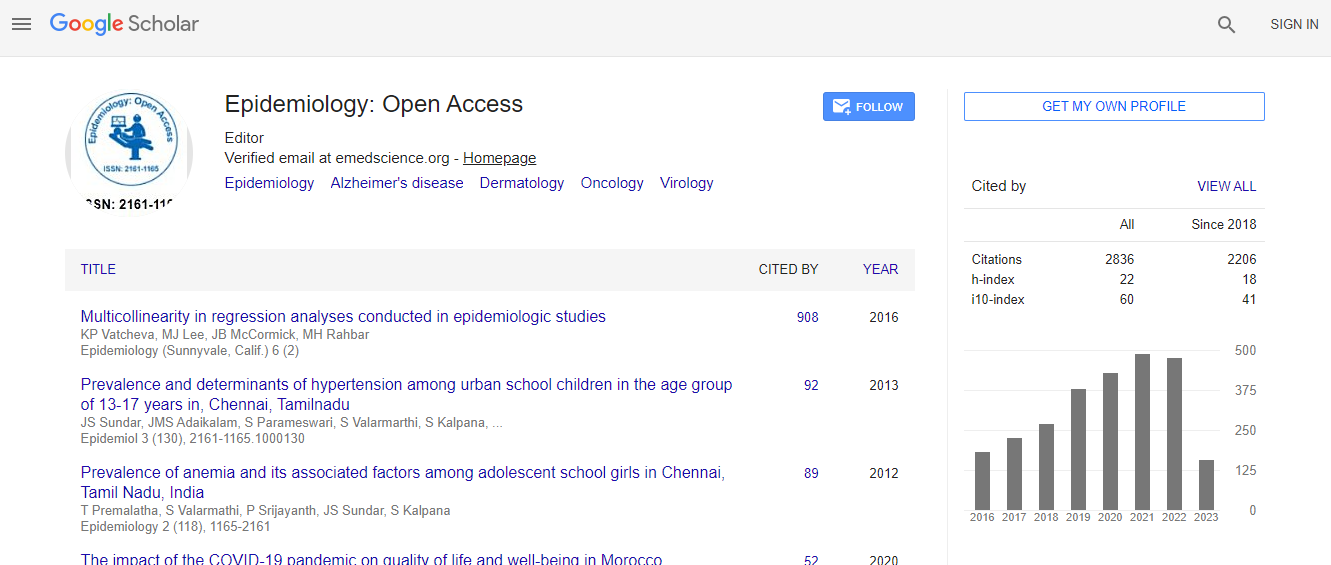Our Group organises 3000+ Global Conferenceseries Events every year across USA, Europe & Asia with support from 1000 more scientific Societies and Publishes 700+ Open Access Journals which contains over 50000 eminent personalities, reputed scientists as editorial board members.
Open Access Journals gaining more Readers and Citations
700 Journals and 15,000,000 Readers Each Journal is getting 25,000+ Readers
Google Scholar citation report
Citations : 3864
Epidemiology: Open Access received 3864 citations as per Google Scholar report
Epidemiology: Open Access peer review process verified at publons
Indexed In
- Index Copernicus
- Google Scholar
- Sherpa Romeo
- Genamics JournalSeek
- SafetyLit
- Access to Global Online Research in Agriculture (AGORA)
- Centre for Agriculture and Biosciences International (CABI)
- RefSeek
- Hamdard University
- EBSCO A-Z
- OCLC- WorldCat
- CABI full text
- Cab direct
- Publons
- Geneva Foundation for Medical Education and Research
- Euro Pub
- ICMJE
Useful Links
Recommended Journals
Related Subjects
Share This Page
Burden of injuries in rural India: Results of a surveillance programme in Tumkur District, Karnataka
3rd International Conference on Epidemiology & Public Health
Gururaj Gopalkrishna, Rao G N, Uttkarsh P, Jayaram A and Venkatesh P
ScientificTracks Abstracts: Epidemiology (Sunnyvale)
Abstract
Introduction: Information on burden, pattern and characteristics of injuries in rural India are not clearly known due to paucity
of data and weak information systems. Even though health sector provides care, injury data is not routinely available and data
from other sectors have major limitations. The programme initiated by WHO collaborating centre at National Institute of
Mental health and Neurosciences in Bangalore, India has successfully used a surveillance approach to build programmes. A
similar approach was developed for a rural district of South India.
Aim & Objectives: To delineate burden, profile and characteristics of injuries in a rural district of India.
Methods: Data was collected from police and hospital sources for a period of one year by trained research officers using
validated questionnaires. The hospital data was collected round the clock from the emergency rooms of district hospital and a
medical college hospital during the period 2008 – 09. A standardized format developed under the Bangalore Injury surveillance
programme was used for collecting information. Data analysis was undertaken using Epi Info.
Results: A total of 2146 injured persons were registered in both centres. Among all injuries, Road traffic injuries constituted the
major burden accounting for more than 50% of all injuries. Assault (20%), followed by poisoning (12%) were the second and
third leading external causes of injuries. Young men were the major groups in all injury causes among both killed and injured.
Two wheeler occupants and pedestrians were the major affected groups. Majority (> 75 %) of the injuries were moderate to
mild in nature and availability of prehospital care was limited.
Conclusion: RTIs are a leading problem even in rural India and coordinated efforts are required for prevention, management
and rehabilitation.
Biography
Gururaj Gopalkrishna is a Professor and Head at Department of Epidemiology, Centre for Public Health, National Institute of Mental Health and Neuro Sciences,
Bangalore, India.

 Spanish
Spanish  Chinese
Chinese  Russian
Russian  German
German  French
French  Japanese
Japanese  Portuguese
Portuguese  Hindi
Hindi 

